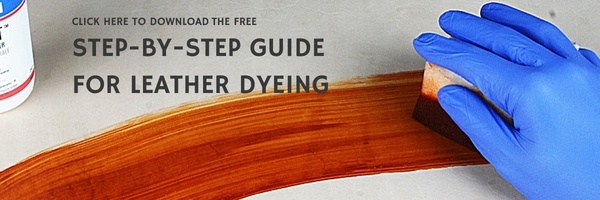Hand painting is a simple leather dyeing process but at the same time it's a very delicate process, during which you have to pay a lot of attention if you want to get a good final result. Using leather dye for leather crafters, to avoid some common mistakes is essential for a good leather finish.
1) Avoid excessive soaking the sponge (or dauber)
Generally during the leather dyeing process a sponge or a dauber is used for the leather dye application. Before the application, be very careful that the sponge or the dauber is not excessively soaked in paint, because this could cause excessive release of leather dye in the first contact with the natural leather, thus creating an overly colored area, difficult to restore to a uniform color.
Another problem caused by soaked sponges is dropping. In fact, if a drop of dye fall on the leather, it would create a little strong colored spot that would be difficult to restore. So this attention is essential to achieve a uniform coloring of the leather surface.
2) Do not rest the hides just dyed on top of each other
Usually when you proceed to the dyeing phase before assembly a leather item, you dyed more pieces of leather one after the other. We must avoid stacking the pieces of leather just dyed on top of each other, in particular we must avoid contacting the grain side of a just dyed leather with the flesh side of the next piece. In this case it can be verified that some hairs of the flesh side remain attached to the grain side of the hide below. It will then be difficult to remove this small hair from the surface of the leather.
3) Avoid taking the dye with the sponge directly from the original bottle
Very often, when you have to quickly dye a piece of leather you may tend to dip the sponge or the dauber directly into the original bottle. Or if you use a separate container, is common to pouring back into the original bottle the leather dye that is left after completing the leather dyeing process. This is a very common mistake but it can ruin the whole bottle!
In fact, whenever we apply the dye on the surface of the leather, the sponge in addition to releasing the dye also absorbs bacteria and part of the leather fibers. When we subsequently soak the sponge in the leather dye, this dirt is transferred into the paint. The leather paint, whether water based or solvent based, is very delicate and can deteriorate, precisely because of this dirt that is introduced, even if in small quantities.
What can occur in water-based paints is that the bacteria will speed up the paint deterioration process, so an unpleasant odor will occur in a short time given by the quick proliferation of bacteria. In solvent-based paints, the tannin acids of the leather can change the pH of the paint by precipitating the dyes, so a separation of the leather dye may occur in a more solid part on the bottom and a more liquid part on the surface.
Avoid drying the paint with an uneven air jet
Hairdryer or a hot air jet can be used to speed up the drying process. In principle, this approach is functional, but you have to be very careful to avoid that the air jet is too direct or too hot, because this would dry some areas more quickly than others, highlighting a color difference. To have a uniform coloration of the leather surface, in case you want to accelerate drying, use a uniform jet of air, with a temperature that does not exceed 70 °C (158 °F).



